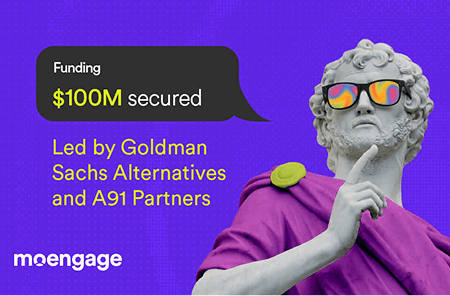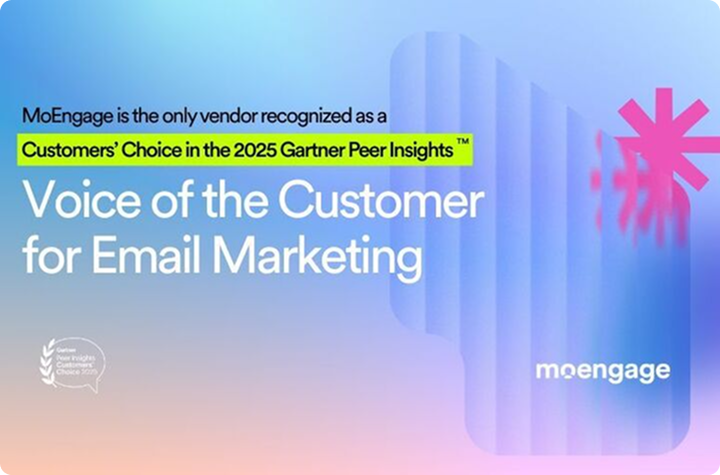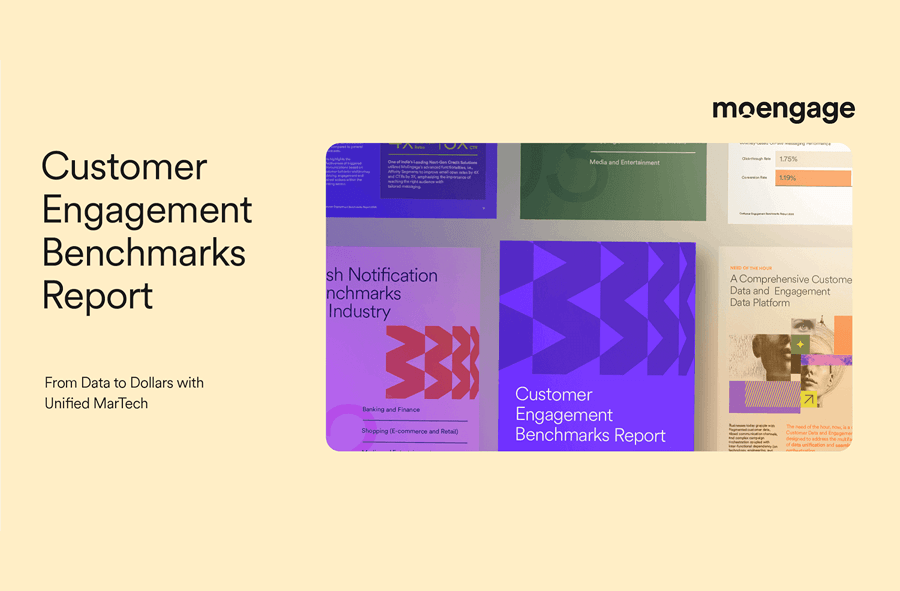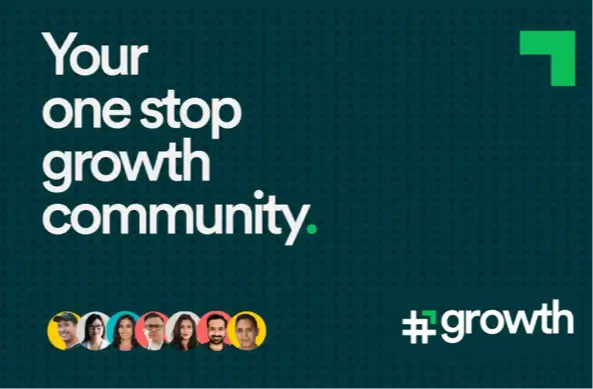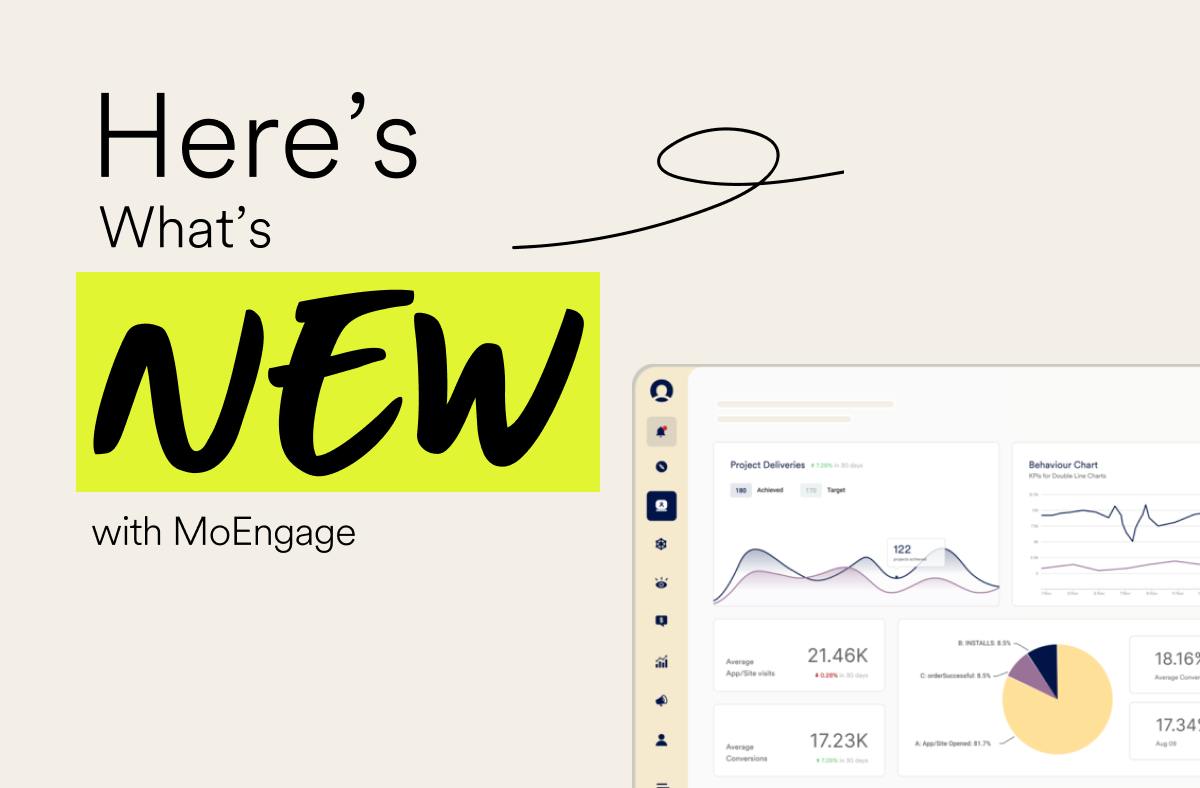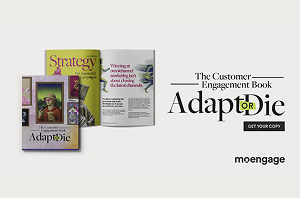[Live Updates]: Apple WWDC 2025 For Marketers
![[Live Updates]: Apple WWDC 2025 For Marketers](https://www.moengage.com/wp-content/uploads/Original-1.png)
Reading Time: 18 minutes
Apple didn’t just announce new OS updates at WWDC 25: it redefined what cross-device customer engagement looks like. From iOS to visionOS, Apple is embedding intelligence, personalization, and connectivity deep into every layer of the customer experience. And while the spotlight was on AI and the new Liquid Glass design, marketers should be paying even closer attention to the infrastructure changes that quietly unlock massive opportunities. In this article, we decode what each OS update means for marketers and how to turn these updates into meaningful, measurable customer experiences.
| NOTE: Note: We’ll be live-blogging from Apple WWDC 25 throughout the week of Jun 9-13. You can bookmark this tab to stay tuned! |
Day 1 Highlights: Apple WWDC 25 For Marketers
Here’s a quick look at the most important system-level updates announced on Day 1 of the conference:
iOS 26: On-Device Intelligence Meets Seamless Expression

Apple announced a sweeping overhaul of iOS with the new Liquid Glass UI, system-wide Apple Intelligence updates, Live Translation across core apps, a new Games app, Wallet order tracking, and CarPlay Live Activities and widgets.
Here’s what matters most for B2C marketers:
- Apple Intelligence brings on-device generative AI, powering smarter personalization, visual search, and content generation with privacy built in.
- Visual Intelligence “Tap to Search”: Customers can long-press images or screenshots across any app to trigger brand or product recognition, which is key for shoppable moments.
- Live Translation in Phone, FaceTime, and Messages enables real-time multilingual engagement for global campaigns.
- Games app & leaderboards: Leverage this for gamified promotions, leaderboards, and brand-sponsored events.
- CarPlay Live Activities & widgets: Create branded glanceable updates, such as order status updates, travel timelines, or loyalty points, right on the CarPlay dashboard.
- Wallet Order Tracking: Push rich post-purchase updates through Apple Wallet, improving the customer experience after checkout.
macOS 26 Tahoe: A Smarter Desktop for Cross-Device CX

macOS 26 Tahoe introduces Liquid Glass visuals, upgraded Spotlight search, menu bar Live Activities, Continuity with iPhone, enhanced Shortcuts, and the Phone app on Mac.
For marketers, this opens up new desktop engagement touchpoints:
- Spotlight Shortcuts: Enable native desktop search actions like “Track my order” or “Find my loyalty card” to create fast, intuitive conversions.
- Live Activities in the Menu Bar: Keep customers updated with real-time order status, events, or delivery ETAs, mirrored from your iOS app.
- Phone on Mac: Extend your CX workflows (support, campaigns, or concierge services) cross-device.
iPadOS 26: Desktop-level Engagement and Intelligent Multitasking

Apple’s iPadOS update from WWDC 25 brings desktop-like windowing, a new Preview app, expanded Shortcuts, Live Translation, and the full suite of Apple Intelligence features to the iPad. For marketers, the iPad just became a powerhouse customer engagement hub:
- Windowing and Preview: Launch side-by-side product pages, demo walkthroughs, or campaigns in real time.
- Live Translation: Create real-time multilingual engagement for global campaigns.
- Visual Intelligence: Leverage in-app content understanding to help customers engage with your app better.
watchOS 26: Glanceable Moments, Now Context-Aware

watchOS 26 comes with Liquid Glass aesthetics, an AI-powered Workout Buddy, Smart Stack widgets, and gesture-based controls for hands-free interactions. Here’s how your brand can stay on-wrist and in-context:
- Smart Stack Widgets let you surface timely, contextual brand content like offers, reminders, or loyalty nudges at just the right moment.
- Workout Buddy: Ideal for wellness and fitness brands, this update delivers contextual prompts and intelligent motivation tied to customer goals.
- Wrist Gestures: Customers can now act on your notifications with the flick of their wrist, perfect for time-sensitive nudges (e.g., flash sales, reminders).
visionOS 26: Spatial Interfaces Get Brand Real Estate

visionOS 26 enhances the Vision Pro experience with spatial widgets, Look-to-Scroll interactions, PlayStation controller support, and on-device Image Playground AI tools.
Marketers exploring AR or immersive retail should take note:
- Spatial Widgets: Anchor branded experiences like product launches, live counters, and shoppable showcases directly into the customer’s physical space.
- Controller Support: Leverage this for interactive VR campaigns, event gamification, or experiential demos.
- Genmoji/Image Playground: Encourage customers to remix brand visuals into personal, shareable formats, building affinity.
tvOS 26: Personalized Profiles Meet Living Room Discovery

tvOS 26 delivers a sleek Liquid Glass design, new multi-profile support, improved Continuity with other Apple devices, and upgraded Apple TV+ experiences. Here’s what makes tvOS matter for B2C marketers:
- Continuity Features: Run synchronized campaigns that bridge mobile, web, and living room touchpoints—great for co-viewing experiences or app-connected promotions.
- Visual Aesthetic: Present content that complements the fluid, immersive living room interface (better visual integration, better recall).
Day 2 Highlights: Apple WWDC 25 For Marketers
Day 2 updates highlight how Apple continues to elevate the way brands engage with customers across apps. From Assistive Access to subscription merchandising, every update empowers marketers to create frictionless, deeply personalized experiences—be it with simplified interfaces, on‑the‑move widgets, or precision offer timing. Let’s dive into what truly matters.
Assistive Access: A Simpler Interface for Cognitive Accessibility
Apple’s iOS and iPadOS 26 updates expand Assistive Access, a mode that allows apps to run in a simplified, full-screen interface designed for customers with cognitive disabilities. Apps can now define a dedicated Assistive Access scene with simplified layouts, large controls, and minimal distractions, making core tasks easier to complete.
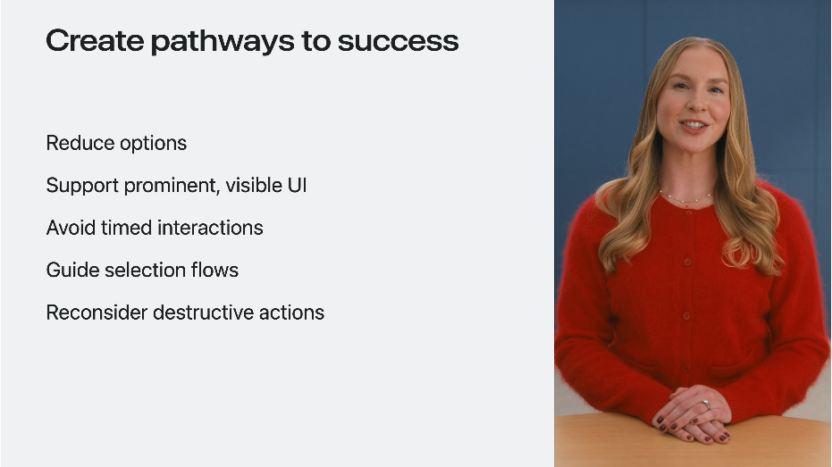
For marketers, this means rethinking how essential app actions like reordering, order status, or redeeming points can be presented with fewer options and clearer steps. To support this, brands must define which 1–2 core actions matter most to Assistive Access customers and expose only those in a simplified flow. Avoid hidden gestures, nested menus, or timed UI elements. Use large buttons, visual cues, and linear paths to completion.
| 💡MoEngage Pro Tip: 💡
Leverage Behavioral Analysis to understand if a particular segment of your customers are finding your app hard to use or navigate, and use this information to define your Assistive App experience! |
Apple Pay and Wallet Just Became a Bigger Part of the Customer Journey
Apple is turning Wallet into more than a storage tool: it’s now a branded touchpoint across the post-purchase lifecycle. Updates this year let you customize how your brand shows up in recurring payment reminders, delivery updates, and event tickets, complete with logos, images, and rich descriptions. That means your brand lives not just at checkout but in every reminder, renewal, and delivery update.

Wallet also auto-detects order emails to provide a sleek interface now, so that customers can find the status of their orders right from the Wallet app. To enable this, make sure you parse the necessary information such as order tracking ID, the merchant name, an order number, and a tracking link to any carriers within the transactional email.
| 💡MoEngage Pro Tip: 💡
Turn Wallet into an owned channel. Encourage customers to add your passes (tickets, boarding passes, loyalty cards) to Wallet via timely in-app messaging. |
🚗 CarPlay: New Touchpoints for Driving Engagement

Apple is transforming CarPlay into an active brand channel with iOS 26 enhancements that bring your app into the driver’s line of sight. Marketers can now deliver compact Live Activities and system widgets on the car dashboard. Imagine a food delivery app showing arrival ETAs alongside maps, or a loyalty app delivering timely reward alerts mid-drive.
Beyond glanceable content, CarPlay also adapts your UI to various screen sizes with Smart Zoom and automatically applies Apple’s Liquid Glass design. For navigation, apps can show multiline rows, image-rich cards, and even display guidance in the heads-up instrument cluster. These updates let navigation and automobile brands deliver seamless, safety-first experiences behind the wheel without adding friction.
| 💡MoEngage Pro Tip: 💡
Leverage User Path Analysis to understand if customers use certain features of your app while they’re in transit. Use this information to craft your CarPlay capabilities. |
Smarter iOS Ad Attribution: Country-Level Insights and Better Re-Engagement Analysis

AdAttributionKit is Apple’s privacy-friendly way to measure ad performance on iOS, like installs and re-engagements, without analyzing individual customers. With iOS 26, it gets three major upgrades that matter to marketers:
- Analyze multiple campaigns at once: Previously, if a customer engaged with more than one ad (say for two different offers), only one campaign could claim credit. Now, Apple lets you attribute actions across multiple re-engagement campaigns, so you don’t lose credit for mid-funnel conversions.
- Country-level postback data: You can now see which country a conversion came from (if there’s enough volume). Use this to optimize segmentation, budget splits, or creative by region, even without third-party customer data.
- Custom attribution windows: You can now tell Apple how long to “remember” a click or view—shorter windows for flash sales, longer ones for high-consideration purchases. No more one-size-fits-all attribution: your campaigns can reflect your actual funnel velocity.
| 💡MoEngage Pro Tip: 💡
Use segmentation to group customers by country-level postback data from Apple. Tailor re-engagement messaging and campaign timing for each segment—shorter journeys for flash sales, longer nurture flows for high-consideration purchases, all without relying on third-party data. |
AlarmKit: A Niche but Powerful Tool for Time-Critical App Use Cases

Apple’s new AlarmKit isn’t meant for every B2C app, but if your product has time-sensitive actions (think: flash sales, appointment check-ins, workout reminders, or medication timers), AlarmKit offers a more persistent, immersive way to nudge customers. These alarms cut through Silent Mode, stay live across device surfaces (Lock Screen, Dynamic Island, Watch), and can be customized with actions like “Open App” or “Repeat Timer.”
| 💡MoEngage Pro Tip: 💡
For customers who snooze or dismiss an alarm, set up event-based push or SMS follow-ups to drive re-engagement at the right moment, especially during limited-time offers or key behavior windows. |
StoreKit Updates: Smarter Ways to Reconnect, Retain, and Monetize
This year’s StoreKit updates open up sharper levers for monetization, especially for apps with in-app purchases or subscriptions. You can now merchandise personalized offers, serve win-back discounts to lapsed customers, and handle crossgrades or downgrades with more logic, based on real-time subscription status. If you’ve ever struggled with the timing or relevance of upsells, this changes the game.
Even better, you can now redeem offer codes across all purchase types (including consumables and non-renewing subs) and securely set eligibility for intro offers or promotional plans using new signed purchase requests. That means better control over who sees what offer and when.
| 💡MoEngage Pro Tip: 💡
Use Behavioral Analysis + Segmentation to identify churn-risk customers, long-lapsed buyers, or down-graders, and then trigger the right in-app offer or notification tied to their current entitlements. Combine with A/B testing to find the best timing and upgrade path. |
Day 3 Highlights: Apple WWDC 25 For Marketers
Day 3 of Apple WWDC 25 brought updates to the App Store, App Analytics, visionOS, and the Map capabilities. Let’s dive in:
Deploy Smarter Subscription Analytics For App Store Apps

Apple is making it easier to recognize and reconnect with paying customers, no matter how or where they subscribed. With recent App Store updates, your app can now tell when a customer has redeemed a promo code, made a purchase on a different device, or restarted a subscription, even if the action happened outside your app. This means fewer dead ends. You can now:
- Welcome customers back seamlessly if they reinstall your app or switch devices
- Tailor your messaging based on their exact subscription history
- Avoid sending irrelevant prompts to consumers who’ve already converted
For example, if someone claims a special offer through the App Store, you can now greet them with personalized content the moment they open your app instead of treating them like new customers.
| 💡MoEngage Pro Tip: 💡
Use app personalization to dynamically adjust what each customer sees based on their subscription status. From showing premium content upfront to hiding upgrade CTAs for paying customers, you can design app experiences that feel tailored, respectful, and conversion-friendly. |
Boost Discovery and Conversions with New App Store Connect Features
Apple is making it easier than ever for marketers to drive discovery and relevance on the App Store. With updates to tags, search keywords, offer codes, and custom product pages, you now have more control over how your app is found—and who finds it.

First, App Store Tags are a powerful new way to surface your app for feature-specific searches. These tags are generated using Apple’s AI but are fully human-reviewed, ensuring quality and consistency. You can view and edit these tags in App Store Connect, so only the most relevant ones are associated with your app. Tap into tags like “guided meditation” or “offline workouts” to appear in themed carousels, search filters, and curated lists, even outside your default category.
Second, Apple now allows you to assign keywords to Custom Product Pages, so they appear directly in search results based on query intent. Want your “Work From Home Fitness” page to rank for “desk workouts”? Just assign the keyword, no resubmission required.
Finally, Offer Codes have expanded beyond subscriptions to include consumables and non-renewing purchases. You can now run more nuanced promotions: for instance, reaching customers who’ve never purchased, or those who dropped off in the last 30 days. Set up campaigns in App Store Connect, distribute via QR or deep links, and identify redemptions directly.
| 💡MoEngage Pro Tip: 💡
Use real-time segmentation to reach customers based on how they interact with your App Store pages. If someone visits a product page but doesn’t install or buy, automatically follow up with a personalized push or email; maybe even include an offer code. Test different messages to see which ones drive the most conversions. |
Pinpoint What’s Working (and What’s Not) with the New App Analytics

With the latest App Analytics revamp, you can now filter, segment, and benchmark app data with more depth than ever. This helps you spot what drives revenue and where drop-offs happen in your funnel.
A key highlight is the Download-to-Paid Conversion and Average Proceeds per Download. These new metrics let you identify how quickly customers convert after install and how much they spend over time. You can also compare your performance to peer benchmarks to see if you’re ahead or falling behind. For example, if your “running” campaign sees poor conversion but strong long-term retention, you’ll know it’s not your product: it’s the messaging or offer.
Plus, cohort analysis tools now let you drill down by custom product pages, territories, device types, and more. You can compare how different audiences convert, subscribe, or churn, all in one place. And if you’re testing trial offers, Apple now shows you exactly how many customers convert from trial to paid, and how long they stay subscribed after.
| 💡MoEngage Pro Tip: 💡
Use Funnel Analysis to mirror Apple’s in-app behavior analysis alongside your push notification, email, and engagement data. Set up journey-based nudges for customers who haven’t converted within 7 days, or run experiments on creatives engaging segments with below-benchmark conversion, so you don’t just see the gap, you close it. |
Reimagine Brand Storytelling with visionOS
Apple’s visionOS isn’t just for developers: it’s a creative playground for B2C marketers ready to craft immersive, premium experiences. With support for branded spatial content, real-time product demos, and location-aware interfaces, visionOS gives marketers new ways to build presence and trust in a crowded digital landscape.
Imagine a travel brand letting customers explore a destination in 3D before booking. Or a fashion retailer offering a virtual try-before-you-buy moment in augmented reality. With Apple’s new APIs like Window Follow Mode and Camera Region Views, these aren’t futuristic fantasies; they’re real possibilities on Apple Vision Pro.
And because visionOS now supports richer, more secure enterprise-grade UI controls, your team can experiment with VIP-only experiences, secure onboarding flows, or exclusive previews, all in a hands-free, heads-up environment.
| 💡MoEngage Pro Tip: 💡
Use customer journey analysis and segmentation to trigger immersive moments based on customer behavior. For example, invite high-intent customers to a visionOS-powered product walkthrough or serve loyalty customers a 3D unboxing experience. |
Personalize Local Discovery with Apple’s Upgraded Maps APIs

Apple’s latest Map updates give marketers new ways to deliver richer, more contextual local experiences on apps and the web. A key feature is PlaceDescriptor, a new way to reference real-world locations even when you don’t have a specific identifier. Whether you’re pulling place data from a CRM, a photo’s GPS tag, or a customer’s typed-in address, you can now surface accurate, live information from Apple Maps, like business hours, descriptions, or reviews, without duplicate data entry.
For marketers, this means:
- Hyperlocal personalization in travel, events, or retail apps.
- Smarter place-based segmentation (e.g., customers who visited a concert venue or store).
- Up-to-date, auto-refreshed listings without manually maintaining location databases.
| 💡MoEngage Pro Tip: 💡
Pair with geo-location-based engagement to nudge customers when they’re near a location, have recently visited, or are exploring nearby points of interest. Whether it’s a coupon, a personalized reminder, or a content push, this update helps marketers bridge digital and physical worlds. |
Day 4 Highlights: Apple WWDC 25 For Marketers
Apple WWDC 25 Day 4 introduced updates to the visionOS via Widgets, a new Games app, interactive snippets, better iconography, and a better Games Center. Let’s dive in.
Bring Your Brand Home: Designing Persistent, Personal Widgets for visionOS
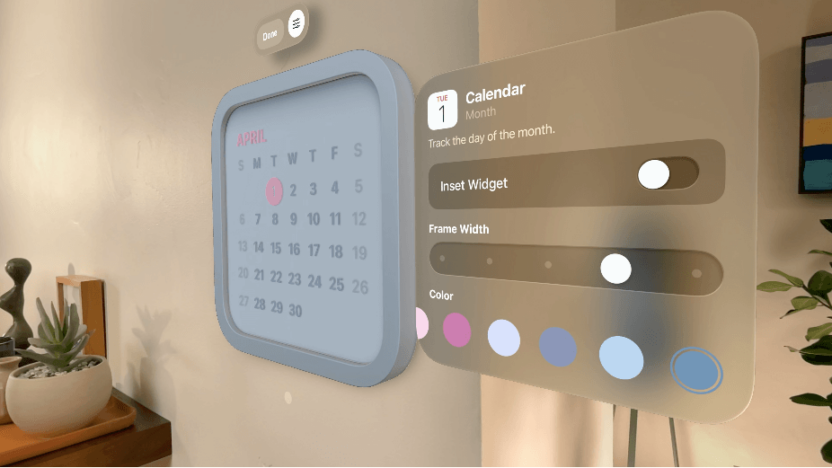
Apple is reimagining widgets for spatial computing, turning them into real-world objects customers can place on their walls, desks, and shelves using Apple Vision Pro. For B2C marketers, this opens up a new ambient channel: always-on brand presence, inside a customer’s physical space.
These 3D widgets aren’t just decorative, they’re customizable, proximity-aware, and glance-friendly. A travel app could offer a weather + countdown widget that lives on a customer’s desk until their trip. A fitness brand could create a “daily movement goal” tracker that’s always visible in a home gym. The widget adapts based on how close someone is, revealing more or less detail automatically, like showing your full itinerary when you walk closer.
Apple offers two visual styles: Paper, for print-like display pieces (think album art, posters), and Glass, ideal for data-rich, high-contrast widgets (like reminders or dashboards). Each can be resized, recolored, and mounted either recessed into the wall or elevated like framed art, creating deeply personal, brand-aligned experiences that persist across sessions.
| 💡MoEngage Pro Tip: 💡
Use Smart Triggers to prompt customers to place your widget when they hit key intent milestones like booking a trip, setting a goal, or starting a challenge. Combine this with in-app personalization to recommend a widget style or theme based on past behavior so your widget doesn’t just live in their room; it belongs there. |
Icons That Sell: A New Era of Brand Expression on the iOS Home Screen
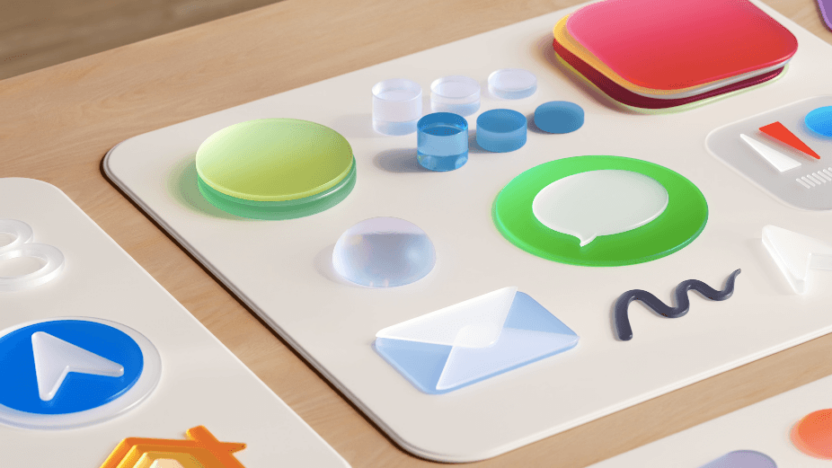
Apple’s new Liquid Glass app icon design isn’t just a visual refresh, it’s a branding opportunity. Inspired by real-world glass properties and adapted from visionOS, these icons now feature layered depth, internal glow, and reactive lighting based on customer movement. They look and feel premium, and more importantly, they make your app stand out before it’s even opened.
This matters for B2C marketers because home screen presence is your first impression, and now, your icon can better reflect the sophistication of your product. Apple’s new appearance modes let you define how your icon behaves across light, dark, and translucent environments. That means whether your customer is on iPhone, iPad, Mac, or Apple Watch, your brand remains consistent and visually engaging. And with unified design grids across platforms, you can ensure brand recall with a single, cohesive identity.
| 💡MoEngage Pro Tip: 💡
When customers long-press your app icon to preview updates or actions, make sure they see personalized content, from time-sensitive offers to recommendations, matching the premium visual experience with high-value utility. |
Let Customers Take Action Faster With Interactive Snippets
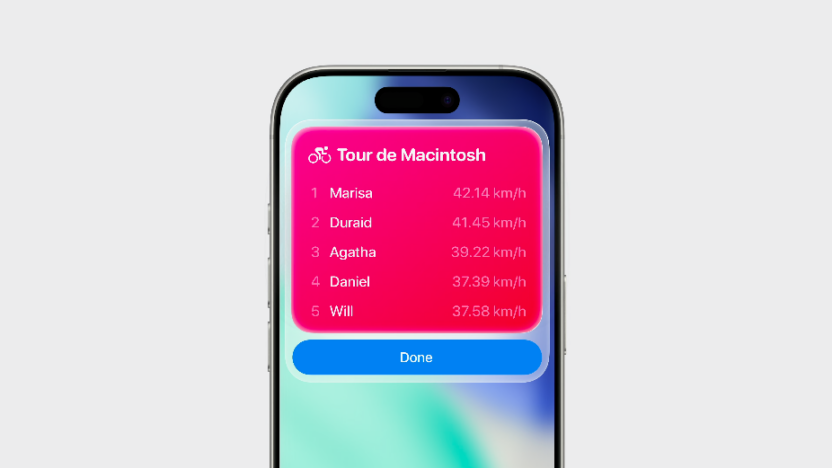
Apple’s new Interactive Snippets turn everyday tasks into instant, glanceable actions directly from Siri, Spotlight, or Shortcuts. These compact, app-branded UI cards let your customers complete simple actions like checking a loyalty balance, applying a promo code, or reordering a product without opening your app.
For B2C marketers, this is a huge leap forward in reducing friction. Want to boost repeat orders? Let customers re-trigger a past action from Spotlight. Promoting daily goals or limited-time offers? Snippets surface key information with bold text, vibrant visuals, and now, interactive buttons. You can even tailor confirmation and result flows, so customers see immediate feedback (like “Order Placed” or “Points Added”) right where they’re searching or speaking.
| 💡MoEngage Pro Tip: 💡
Nudges like “Reorder your last purchase with one tap” or “Top up your wallet via Siri” can link directly into snippets. Analyze completions to optimize conversion paths across search, voice, and app entry points. |
Game Center Gets a Power-Up
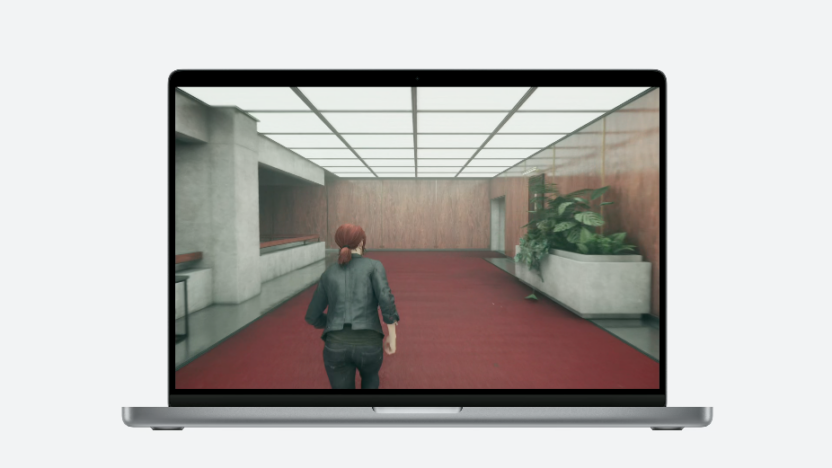
Apple is putting Game Center front and center again, and this time, it’s not just for developers. With new visibility in the Apple Games app, Game Center now helps games get discovered through “Top Played” charts and “Friends Are Playing” feeds, both in the App Store and the new Games app. Social discovery is no longer just a bonus; it’s built into the ecosystem.
Game Center’s Achievements, Leaderboards, and all-new Challenges turn even single-player games into shareable, social experiences. With no extra code required, brands can use existing leaderboards to power time-bound challenges where players invite friends, compete, and trigger rematches with a tap.
For brands with gaming properties, these features don’t just drive replayability; they create organic, referral-driven growth. Even better, Apple’s new Activities feature lets you deep link players directly to specific in-game actions like starting a level, redeeming a reward, or joining a multiplayer match with a party code. That means less drop-off, more action, and stickier gameplay loops.
| 💡MoEngage Pro Tip: 💡
Leverage Dynamic Segments to trigger personalized re-engagement flows based on player actions inside Game Center. For example, send a push when a gamer is invited to a challenge but hasn’t joined yet, or run an in-app campaign to nudge leaderboard-toppers toward premium upgrades. |
The Games App: A New Front Door for Discovery
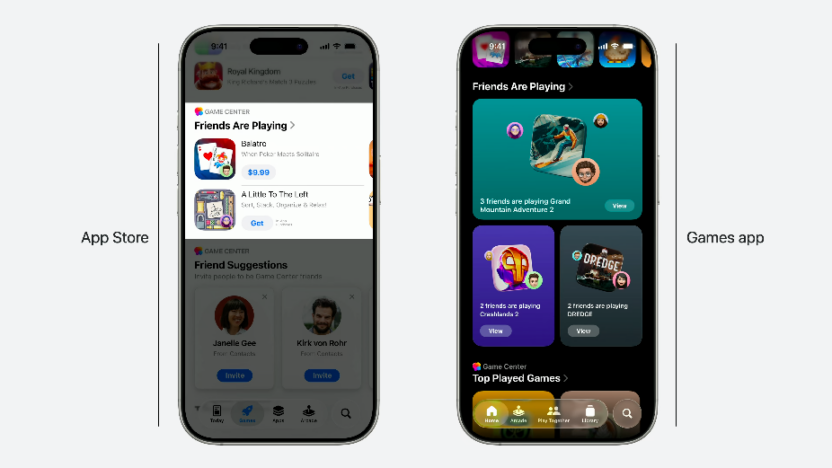
Apple’s new Games app is fast becoming the daily hangout for players across iPhone, iPad, and Mac. It’s a dedicated, pre-installed hub where players can track their progress, discover new games, and—most importantly—see what their friends are playing.
For marketers, this opens up a powerful new opportunity: virality through visibility. Game pages now showcase Game Center data (achievements, leaderboards, challenges), events, and even multiplayer activity. If your players are active, your game is visible.
If you want even more control, create in-app events (seasonal drops, limited-time tournaments, or new content launches) and set deep links to take players directly into gameplay. These show up across the Games app: on homepages, in search results, and even as push alerts for friends.
| 💡MoEngage Pro Tip: 💡
Use behavior-based triggers (like drop-offs before event start or leaderboard losses) to nudge players back in with personalized messages. Bonus: embed deep links so they can jump straight into the action. |
Day 5 Highlights: Apple WWDC 25 For Marketers
The last day of Apple WWDC 25 is all about personalization: on language, with privacy, across AI, and while browsing.
Language Discovery: The Next Frontier in Personalization

In iOS 26, Apple introduces Language Discovery, a subtle but powerful shift for multilingual personalization. Until now, marketers had to rely on device language settings to infer language preferences. But that no longer tells the full story, especially in regions like the Middle East, Southeast Asia, and India, where multilingual behavior is the norm.
With Language Discovery, iOS 26 surfaces actual usage patterns such as what languages a person texts in, listens to music in, or reads news in, and uses that to personalize recommendations for apps like Music, News, Calendar, and Translate. This unlocks a new opportunity for marketers: hyper-relevant multilingual content delivery without customer input.
Instead of asking customers to pick their preferred language, your app can now dynamically surface content in the right languages using this information. Whether you’re a music app recommending lyrics in Arabic and Mandarin, or a commerce brand sending push notifications in Bahasa and Tamil based on language behavior, this opens up a smarter, more respectful form of localization.
| 💡MoEngage Pro Tip: 💡
Deploy app personalization and customize the entire app experience for each locale of customers, based on their preferred language. |
On-Device Generative AI for Personalization, Without the Privacy Trade-Off

Apple’s new Foundation Models framework brings a major shift for marketers: you can now use on-device generative AI to deliver personalized, content-rich experiences, without sending any customer data to a server. Whether it’s summarizing a customer’s activity, tagging interests, or generating travel itineraries, Apple Intelligence now gives your app the power to understand and act on customer input natively, with zero data leaving the device.
This could translate to dynamic onboarding journeys based on customer goals, or auto-generating headlines, recommendations, or summaries in-app. The real unlock is Guided Generation, which ensures that model responses are always structured, so your UI and logic stay predictable.
| 💡MoEngage Pro Tip: 💡
Use customer journey orchestration to trigger hyper-personalized, AI-powered content based on customer preferences! |
Age-Aware Personalization, Now Built Into iOS

With iOS 26, Apple introduced the Declared Age Range API, giving apps a privacy-preserving way to tailor experiences for kids, teens, and adults without ever collecting a birthdate. This is a major win for marketers and product teams looking to deliver age-appropriate personalization while staying compliant with privacy regulations like COPPA, GDPR-K, and India’s DPDP Act.
Apps can now prompt customers (or their guardians) to share their age range—like “12 and under” or “16 and over”—to unlock specific features. You don’t get exact ages, just the bracket you need to responsibly customize the UI, gate certain content, or activate parental controls. Apple also ensures this data is cached, synced across devices, and not repeatedly surfaced to customers.
| 💡MoEngage Pro Tip: 💡
Leverage attribute-based personalization to dynamically adjust customer journeys based on the declared age range. |
Scroll-Powered Stories: Bring Your Brand to Life with Motion
The new Safari introduces scroll-driven animations, letting you create delightful visual effects that respond to how customers scroll, without needing complex code or JavaScript. For marketers, this is a subtle but powerful way to make your website feel more alive, personal, and premium.
Imagine a landing page where product tiles slide in as you scroll, a progress bar that fills up as a customer explores your brand story, or a testimonials section where reviews “snap” into view only when they’re relevant, drawing attention without being distracting. These aren’t just fun flourishes; they’re ways to guide attention, reinforce storytelling, and create a sense of polish that boosts brand perception.
Even better? These animations are accessible-friendly and responsive, adjusting smoothly across devices while respecting customer preferences (like reduced motion settings). There is no need to worry about alienating customers sensitive to motion.
| 💡MoEngage Pro Tip: 💡
Use Smart Triggered messages to layer conversion nudges on top of these moments, like an exclusive offer when a product scrolls into view, or a CTA when someone reaches a key milestone on your page. |
That’s All From Apple WWDC 25 For Marketers!
The takeaways from Days 1-4 of Apple WWDC 2025 are clear: Apple is building an ecosystem where brand experiences aren’t just mobile-first: they’re context-first, intelligent, and seamlessly omnichannel. Whether it’s real-time translation, spatial widgets, or Live Activities on CarPlay and the Mac menu bar, the opportunities to show up in your customer’s journey, proactively and helpfully, have never been greater.
As marketers, it’s our job to translate these product upgrades into emotional, relevant moments that convert. And with Apple doing the heavy lifting on intelligence, interactivity, and infrastructure, the brands that adapt fastest will be the ones consumers remember most.

